08/01/2025
How to buy a used car directly from abroad (and how carVertical can help)

Buying a used car from abroad can open the door to better deals, unique models, and access to a broader range of makes and trims than you might find locally. However, without proper planning and a thorough background check of the car, you could run into unexpected fees, legal hurdles, or even scam attempts.
From understanding country-specific rules and local compliance standards to verifying a vehicle’s history and condition with the help of a carVertical report, following these guidelines can help ensure you find a great deal while reducing risks.

Afraid of buying a wreck?
Check any VIN to learn a vehicle's history!
Understand the import regulations for your home country
Before deciding whether to buy an imported car, it’s important to understand the regulations that apply to vehicles coming into your country. Factors such as whether the car comes from an EU or non-EU country, its age, engine type, and emissions class can all influence the taxes, documentation, and inspections you might require.
Taxes and fees
When importing a car, you’ll likely have to deal with several types of taxes and fees:
- VAT (Value Added Tax): Typically applied when buying from dealers, but rules can vary by country and whether the vehicle is new, used, or considered a collector’s item. Some older classics may even qualify for lower VAT rates.
- Customs duties: For EU imports, there are no customs duties thanks to free trade within the bloc. If you’re importing from outside the EU, though, expect customs duties that depend on the country of origin and local trade agreements.
- Registration or environmental taxes: Many European countries impose extra registration or environmental fees. For instance, the Netherlands has a BPM tax based on the car’s CO₂ emissions. Electric and hybrid vehicles may receive reduced rates, while older, high-emission cars usually attract higher fees.
Tip: Always check these details on official government websites or by contacting customs authorities. Different vehicle categories, like commercial vs. passenger, electric vs. combustion, and so on, might follow different procedures or rates.
Required documents
Easier importing requires having all the correct paperwork. In general, you will need:
- Proof of purchase (invoice or bill of sale)
- Original registration documents of the vehicle
- Certificate of Conformity (CoC) to prove the car meets specific technical standards
- Any additional documents required by local laws (e.g., in Belgium, sellers must provide mileage records from every servicing).
Make sure you know which documents are needed both in the country you’re buying from and in your home country – it can save a lot of trouble later.
Inspection and testing requirements
In many countries, a technical examination or roadworthiness test must be completed before a car can be registered.
For instance, in the UK, vehicles require an MOT test to ensure compliance with safety and environmental standards. In Germany, a TÜV (Technischer Überwachungsverein) inspection is necessary to certify roadworthiness.
Expect additional checks for emissions, safety equipment, and structural integrity.
Special regulations for non-EU imports
Cars arriving from outside the EU often face stricter checks and may need adjustments to meet local standards. For example, a car from the US might need modifications before registration, like conforming to EU emissions limits or noise regulations.
Pro tip: To confirm a car’s emissions class or check if it meets local standards, you can use a carVertical report, which often includes emissions data.

Check local rules for compliance
Import regulations often vary not only between EU and non-EU countries but also within individual EU member states. Understanding and following them is critical to ensuring an imported car can be legally driven and registered in your country.
- Local emissions regulations: These regulations can impact where and how you drive. For instance, many cities, such as Paris, Berlin, and London, have Low Emission Zones (LEZ) or Ultra Low Emission Zones (ULEZ) that restrict higher-emission vehicles. Ensure the imported car meets these standards if you plan to drive in such zones regularly.
- Safety and technical adjustments: Check technical and safety requirements to ensure that your imported car is safe and legally compliant with local driving conditions. For example, cars from countries with left-hand traffic may require headlight alignment, and cars from countries using miles per hour (mph) may need a speedometer update to show kilometers per hour.
- Vehicle type restrictions: Some countries limit imports based on the car’s age, engine size, or emissions category. To ensure compliance with relevant regulations, you can use a carVertical report to verify the car’s original specifications even before contacting the seller.
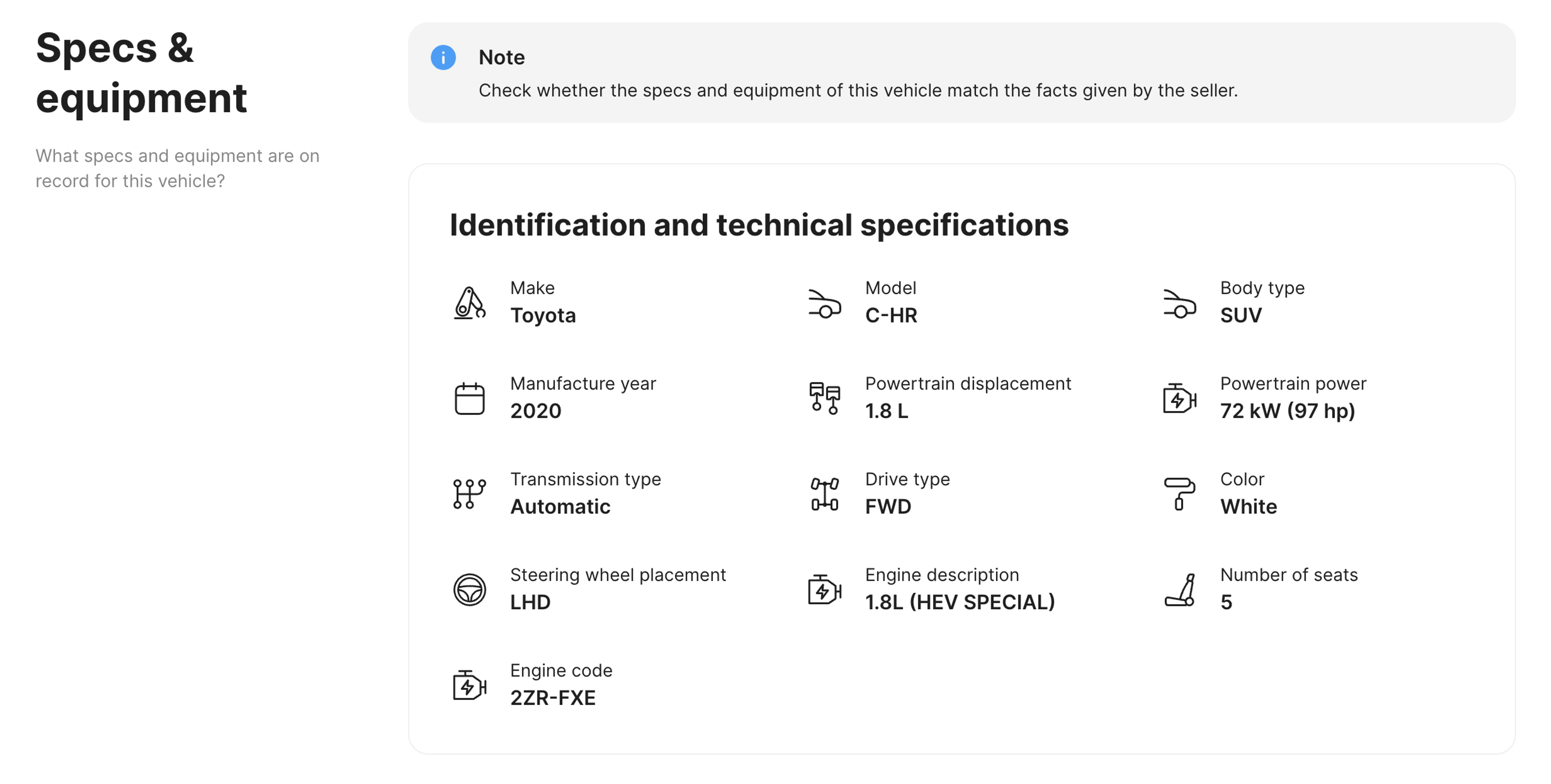
Plan your finances
So how much does it cost to import a car? While costs vary depending on the country of origin and type of vehicle, proper research can help you determine if you’re getting a good deal compared to local prices. Start by deciding on a reasonable budget, leaving a buffer for unexpected costs.
- Car price: The car price is a central component of the financial planning process, as it sets the foundation for the overall budget. Research similar makes and models online to understand the price range and determine how much you can afford to spend.
- Market value check: Use the carVertical report, including its market value feature to determine if the asking price is reasonable, identify inflated prices, and avoid overpaying/hidden issues.
- Additional costs: Consider taxes, customs duties, inspection fees, potential modifications for emissions compliance, repairs, and shipping costs. This will give you a more accurate estimate of the total cost of importing a car.
Tip: Always pay by credit card or bank transfer – avoid cash or unsecured payment methods to ensure traceability and legal protection.
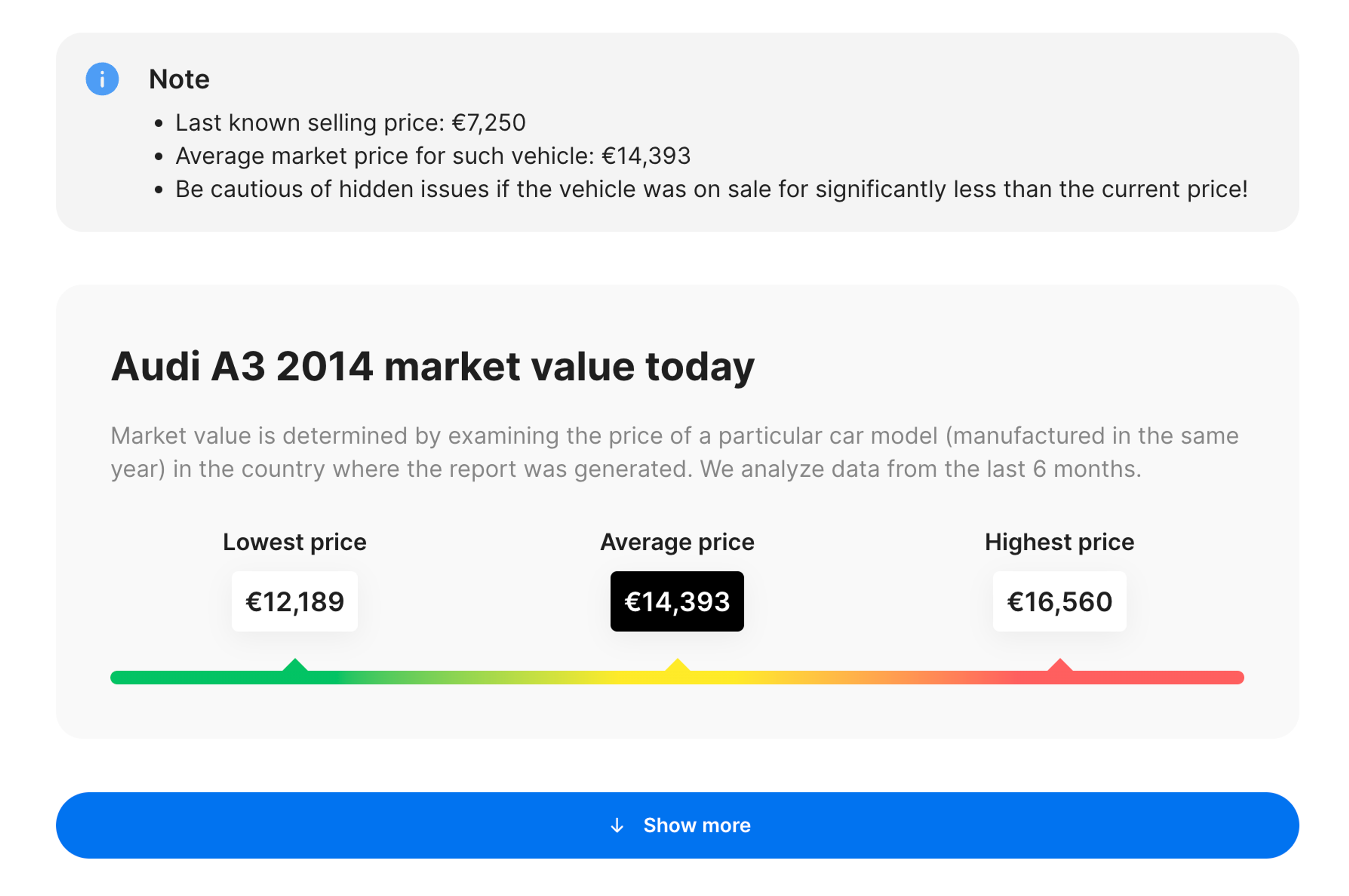
Find a reliable seller
Some buyers look for the cheapest country to buy cars in Europe, comparing listings and sellers to decide if importing is worth it. Before going ahead, thoroughly check each seller’s reliability to avoid any hidden costs or scams:
- Check the seller’s reputation: Do a quick search to see if there are any complaints. Review the seller’s online presence, look up online reviews, local forums, or buyer feedback. If it’s a dealership, verify its registrations with authorities.
- Evaluate transparency: Reliable sellers provide detailed listings, show willingness to answer questions, and allow inspections.
- Compare prices: Significantly below average prices could indicate hidden issues or scam attempts.
- Confirm ownership: Request proof of ownership, e.g., the original registration document.
If a seller makes you feel uneasy, avoids answering your questions, or seems unwilling to provide clear and transparent information, it’s a strong indicator that proceeding with them could be a significant risk that’s not worth taking.
Get to know the car inside and out before buying
Performing proper diligence on the vehicle’s history and condition is very important when planning to import a car. A thorough early-on approach can help you avoid costly issues that sometimes arise when importing a car from Europe or elsewhere.
Ask for help from a local expert
If you can’t personally travel to inspect the car, consider hiring a local person (a friend or recommended professional) to verify that the vehicle matches the seller’s claims. They can look at its exterior condition, confirm the VIN, and give you an unbiased assessment.
Additionally, there are specialized companies that assist with buying cars abroad. These services can handle everything from vehicle inspections and paperwork to shipping and customs clearance.
Regardless of whether you’re buying the car through mediators or handling the process yourself, don’t skip checking the car’s history via a carVertical VIN check. Some buyers use mediators, providing basic requirements and payment while leaving the rest to them. However, conducting this part of the research yourself gives you more control and can lead to an even better outcome, ensuring you make a fully informed decision.

Check your VIN
Avoid costly problems by checking a vehicle's history. Get a report instantly!
Understand the nuances of the mileage curve
Mileage strongly influences a car’s value and condition, and odometer tampering is a common scam, especially for imports. Always verify the car’s mileage with a carVertical report to avoid odometer rollbacks and identify other suspicious patterns.
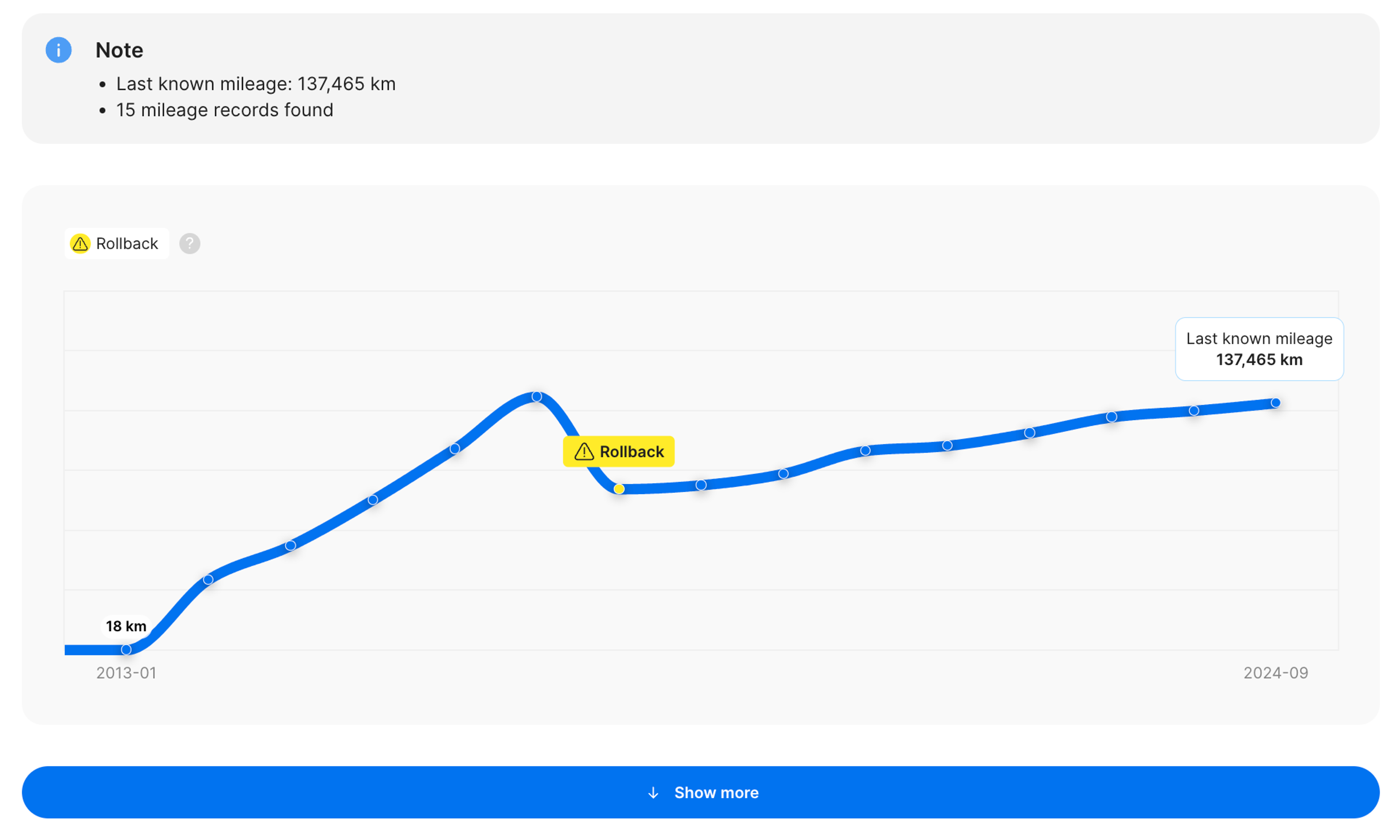
Some common red flags in the mileage history are:
- Irregular gaps: Large intervals that are unaccounted for between recorded mileages could indicate missing records or a lack of regular maintenance.
- Stagnation: If mileage does not change over long periods, the car may have been off the road due to major mechanical issues or damage.
- Low mileage: If the mileage is unusually low for the age of the car, consider whether it was underused or if someone tampered with the odometer.
Assess the damage history
A car’s damage history can help you better evaluate its true condition and become more aware of potential future problems. Therefore, it’s crucial to learn about any past accidents before buying any used car.
For example, the excerpt from the carVertical report below shows a severely damaged BMW, with an estimated repair cost between €10,001 and €15,000.
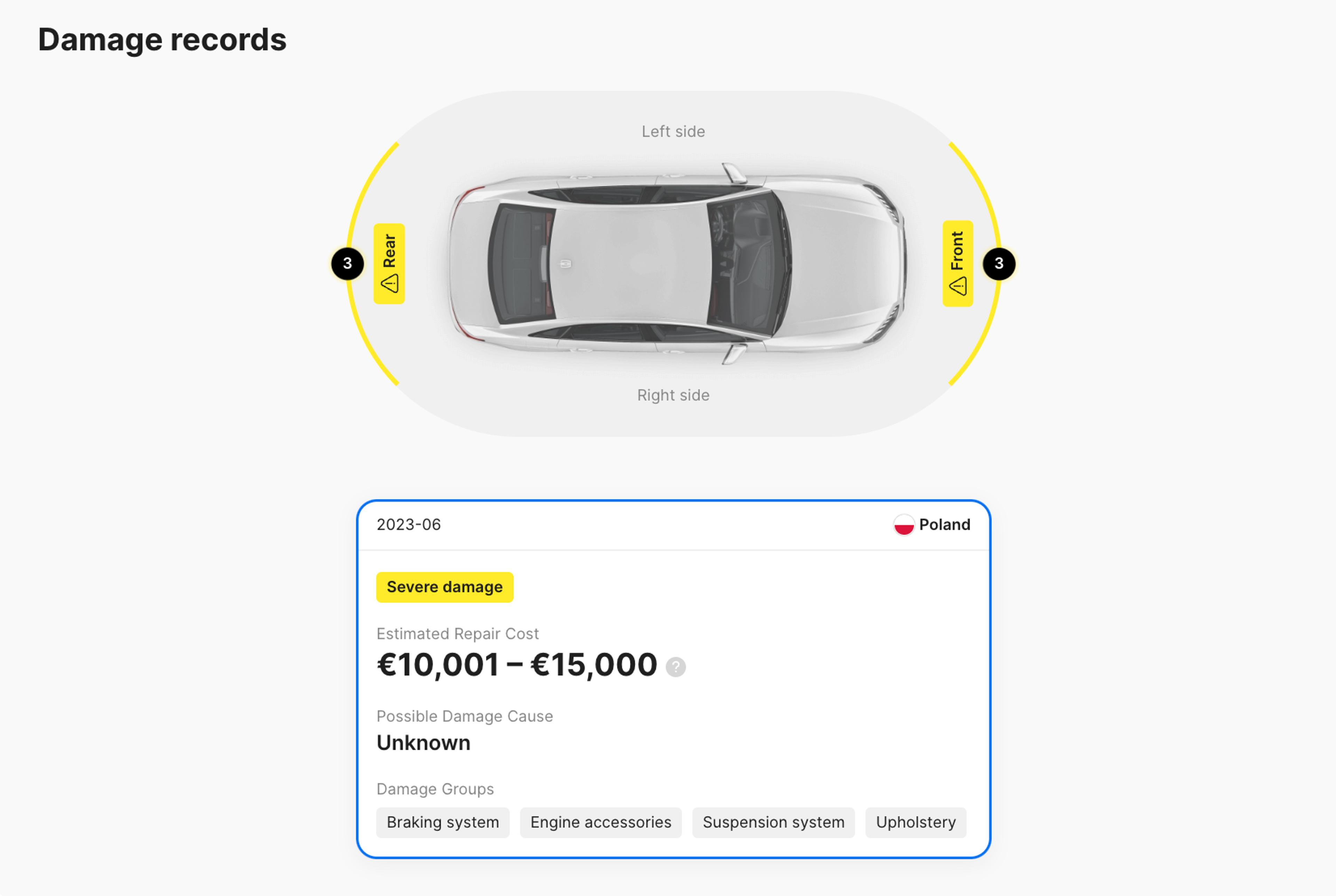
If damaged areas, such as the braking system, engine accessories, and suspension system, were poorly fixed, you might face issues that resurface after purchase. This can not only affect the car's performance and safety but also lead to expensive repairs.
If importing from the US, pay special attention to title brands. Vehicles with branded titles, like salvage or rebuilt, may have suffered major accidents or flood damage and could still have lingering issues.
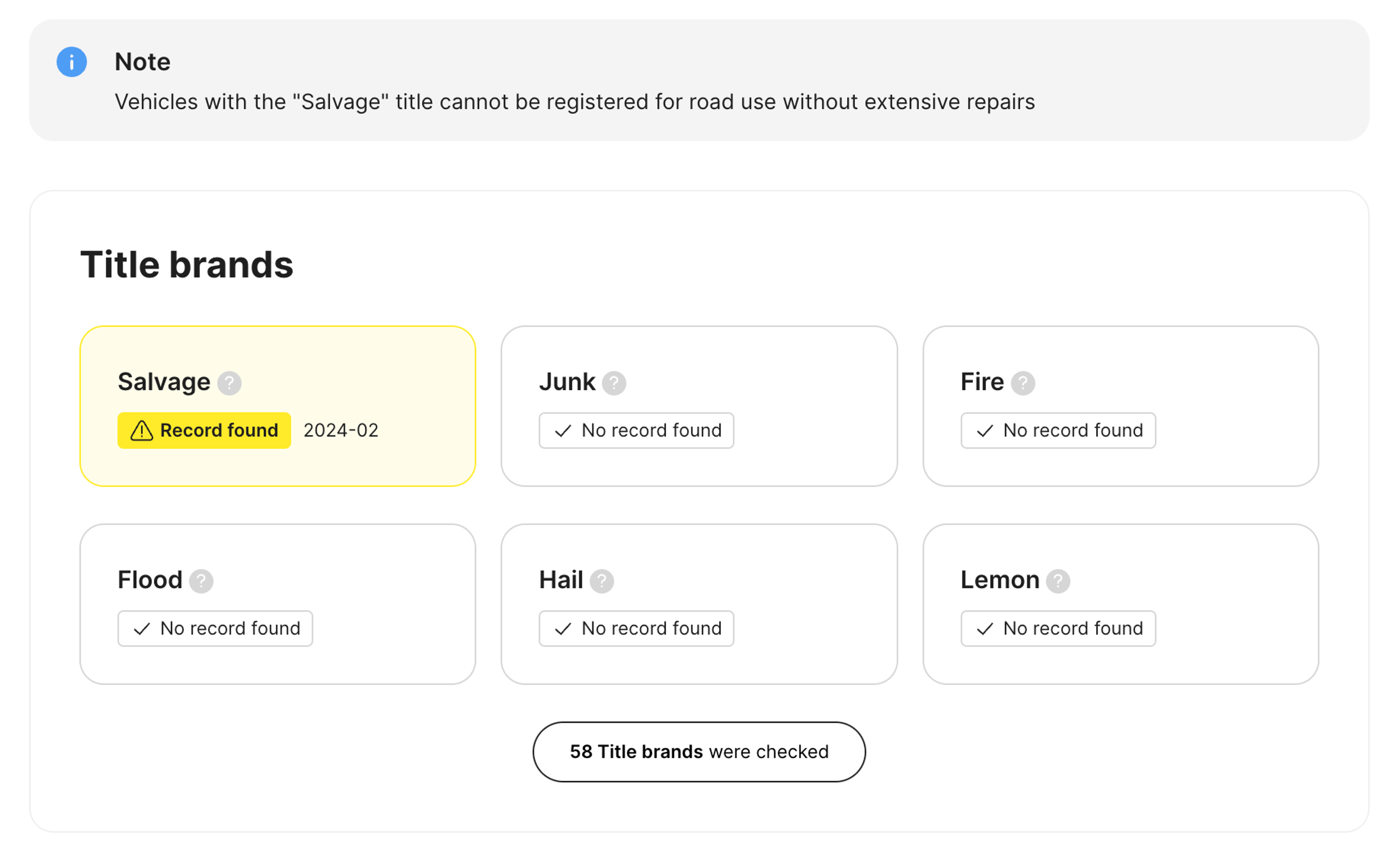
Check ownership and usage history
Knowing how many owners the car had can provide valuable insights into how well it has been maintained and even indicate potential issues if the ownership has changed frequently. For this, it is also important to understand the ownership type and whether the car has been subjected to any unusual conditions.
You can gain a clearer picture by cross-referencing the information in the Timeline and Purpose sections of the carVertical report.
While the Timeline section can show ownership changes, the Purpose section in the report can reveal if the car was used by law enforcement, rental companies, or some other commercial purposes.
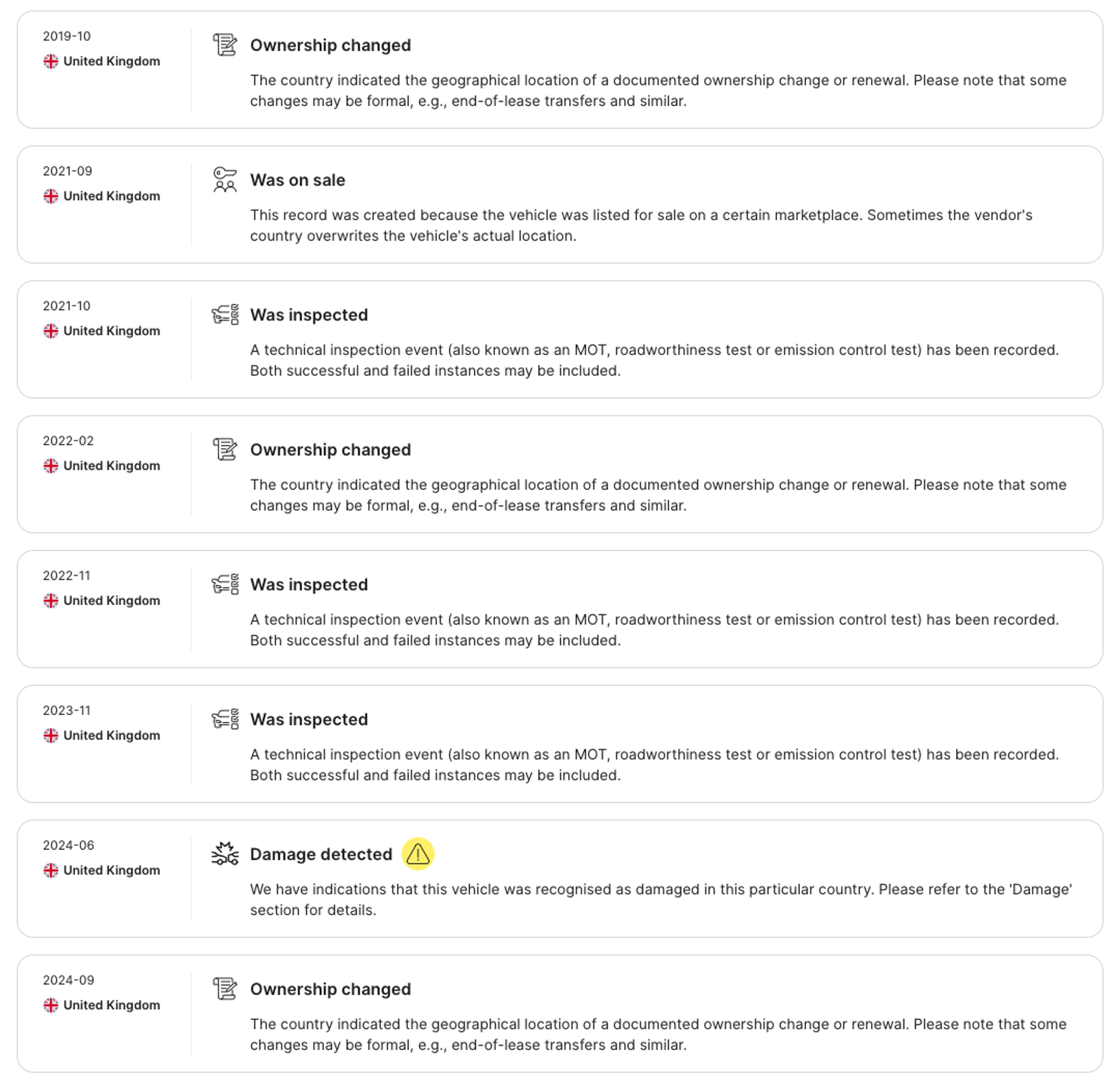
Purchasing an ex-taxi, police car, or rental vehicle without knowing its history can pose risks, as these vehicles are often subjected to heavier use, frequent driving, and potentially harsh conditions. Ex-taxis and police cars may have higher mileage, while rental cars might have been driven by multiple, sometimes inexperienced drivers. These factors can lead to increased wear and tear, making the car more prone to mechanical issues and affecting its overall reliability.

Look for visible signs of wear and tear
If possible, inspect the car in person or request a full set of detailed photos. Look for:
- Body condition: Dents, scratches, rust, or uneven paintwork, which can mean past accidents or sloppy repairs.
- Paint quality: Faded or peeling paint might suggest harsh environmental exposure.
- Glass and lights: Cracks or chips in windows, mirrors, or headlights can be costly to repair.
- Tires: Uneven tire wear may mean alignment issues or suspension problems.
- Interior: Torn upholstery, unpleasant odors, and stained carpeting may point to neglect.
- Engine bay: Look for fluid leaks, cracked hoses, or worn belts.
If you can’t see the car in person, thoroughly investigate the pictures in the listing (and ask the seller to share more, or even record a video). A carVertical report may also include historical photographs from previous inspections, auctions, or insurance evaluations, which can be helpful for spotting prior damage!
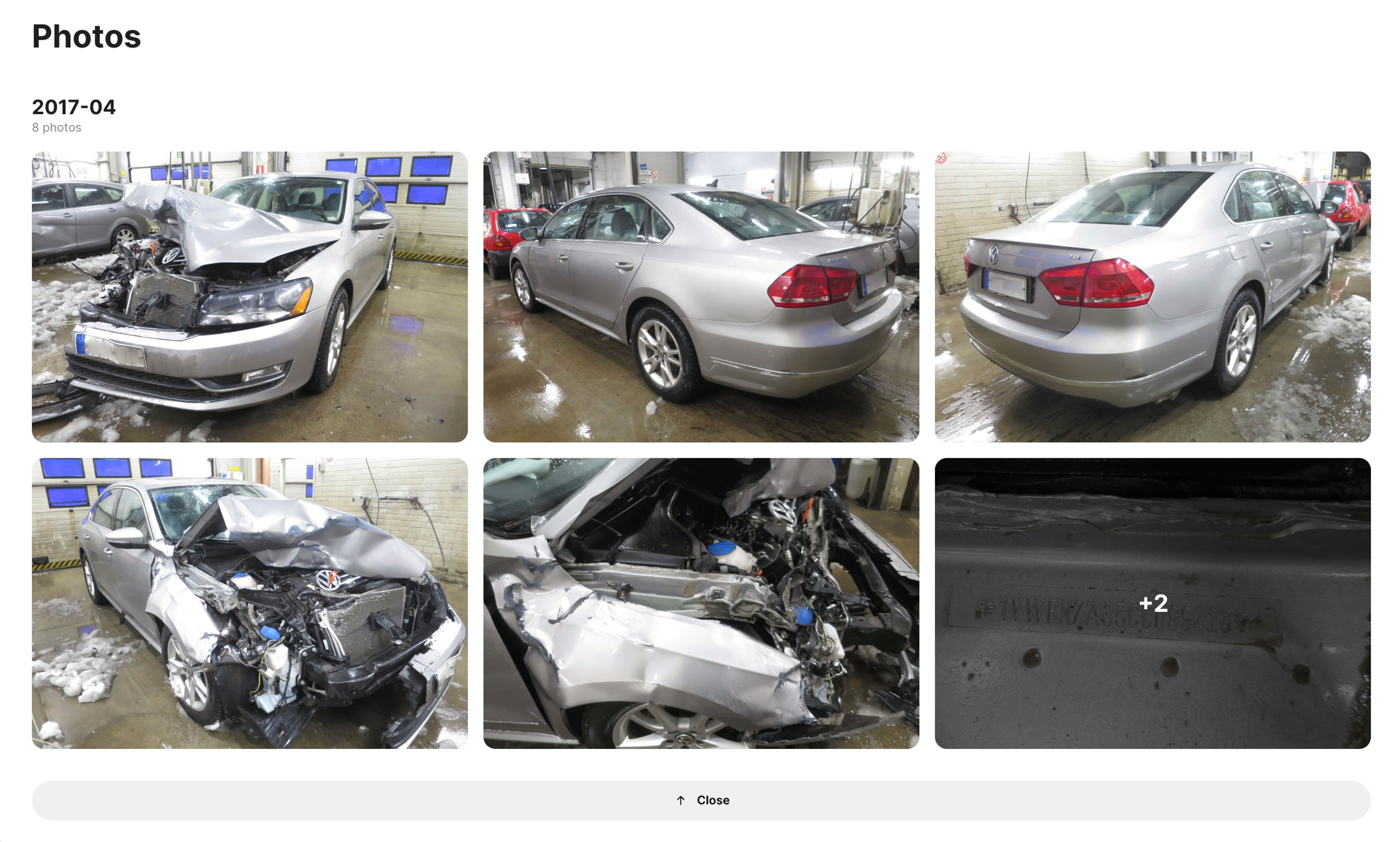
Test drive the car
A test drive is one of the most important steps in evaluating a car before purchasing, as it allows you to assess its performance, comfort, and any potential mechanical issues. If you’re able to visit the seller abroad, a test drive can provide important insights:
- Check acceleration and braking: Ensure the engine responds smoothly and the brakes function properly.
- Listen for unusual sounds: Squeaks, rattles, or grinding noises may indicate issues.
- Assess comfort and handling: A smooth ride and responsive steering are good signs.
- Check instruments and electronics: Make sure all lights, gauges, and infotainment systems are working.
Get a professional inspection
A professional inspection is vital, especially if you’re buying from afar. A local mechanic or inspection service can verify the car’s condition remotely, sometimes via video calls. They can help detect tricky issues, as in a car registered as a different type of vehicle (e.g., a van instead of an SUV), which can cause legal headaches later.
Plan shipping and customs clearance
Once you’ve confirmed the car’s condition, it’s time to get it home. Again, careful planning leads to the best results:
1.Research transport costs: Think about shipping fees, transit insurance, and storage charges.
2.Choose a transportation method: Options include driving the car yourself, hiring a car carrier, or shipping by sea.
3.Handle import duties and taxes: Depending on the route and country of origin, these can vary.
4.Prepare necessary documents: Ensure customs paperwork is complete to avoid delays.
5.Arrange delivery and pickup: Consider logistics costs if the nearest port or delivery hub is far from your location.
Distance within Europe can also influence costs. For example, importing a car from more distant regions of Germany may pose challenges if you’re located in one of the Baltic countries (or cost significantly more).
Always factor in various scenarios and shipping routes, as it can account for potential delays and additional costs.
Register your imported car
Finally, you’ll need to register the imported car in your home country. This typically involves:
- Providing necessary documents: Including your proof of purchase, CoC, and any inspection certificates.
- Paying registration fees: Often tied to the car’s emissions, engine size, or type.
- Submitting an application at the local vehicle registration authority: Expect a waiting period before your plates and documents are issued.
When importing a car, it's important to thoroughly research and learn as much as possible about the vehicle. Understanding its history, condition, and any potential issues will help ensure you make a well-informed decision. Taking the time to gather all relevant information can prevent future problems and lead to a more successful purchase.
